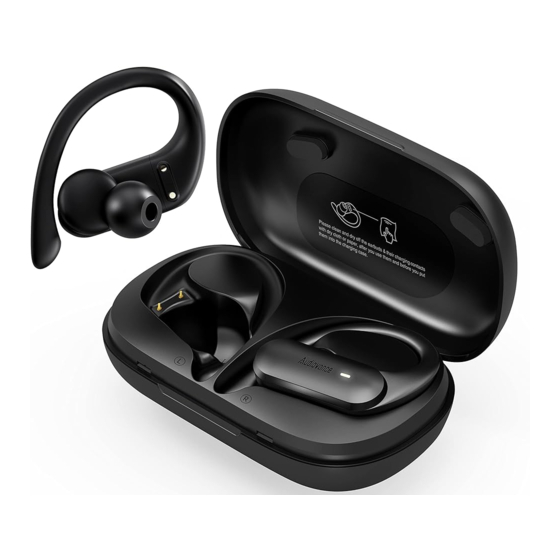
Advertisement
Table of Contents
FAQs for Audiovance SP301 Earbuds
Index
1.
Operation
2.
3.
4.
5.
6.
1. Operation
1.1 How should I look after SP301 properly?
1)
Use the earbuds regularly to avoid over-discharge that can harm the lifespan of the earbuds' battery.
We recommend using SP301 at least once a month.
2)
Place the earbuds into charging case for their recharging every time after using them. Leaving them
out of charging case is apt to cause over-discharge of earbuds.
3)
If you intend to store the charging case, it's better to fully charge the case or at least charge it to 66%
above level.
4)
Clean the charging pins on the earbuds and charging case regularly for good contact.
5)
Keep the ear tips clean.
6)
Keep the microphone hole unobstructed.
7)
If you use a hairdryer when earbuds contact liquid, please make sure it's 'cool' wind coming out.
1.2 How can I power the earbuds on/off?
Power on:
-When you get the new earbuds for the 1
charging connectors on the earbuds, then place them back into the charging case to power on.
-The earbuds will turn on automatically when you open the charging case.
Power off:
-Put the earbuds back into the charging case and close the lid, the earbuds will turn off automatically.
-When earbuds have been outside the case and disconnected with your device for 5 minutes, they will turn
off automatically.
1.3 Can I manually turn on/off either side of the earbud?
Yes, you can manually turn on/off the individual earbud by
-Long tapping 5 seconds to turn off the earbud,
-Long tapping 2 seconds to turn on the earbud.
1.4 How do I avoid triggering the touchpad of earbuds by accident when adjusting their position in my
ears or when handling my hair?
-Comparing to other earbuds, SP301 brings less trouble in touch control because Play/Pause and
Answer/Hang up are triggered by tapping twice, avoiding the problems by accident.
-Avoid touching the area of Audiovance Logo on earbuds is helpful.
1.5 Why is the touch control not responsive every time?
Please make sure you are tapping the right spot on SP301 (area along Audiovance Logo on earbuds).
Please make sure each tap is in the right spot within 1 second when you double or triple tap.
st
time using, please remove the protective film covering the
Advertisement
Table of Contents

Summary of Contents for Audiovance SP301
- Page 1 1.5 Why is the touch control not responsive every time? Please make sure you are tapping the right spot on SP301 (area along Audiovance Logo on earbuds). Please make sure each tap is in the right spot within 1 second when you double or triple tap.
- Page 2 2. Bluetooth 2.1 How do I connect SP301 when I use it the first time? Step 1: Please make sure you remove the protective film from the earbuds when you get it from Audiovance or seller. Step 2: Put the earbuds back into the charging case and close the lid to power on the earbuds.
- Page 3 After Repairing, you can see Audiovance SP301 in the Bluetooth list of your second device for connecting. 2.5 How do I set up SP301 when I want to use them to make calls via a Windows computer? -Set up both the microphone and speaker as "Hands-Free". Note: -If the microphone is set as "Hands-Free"...
- Page 4 3.5 Setting the input and output on a Windows computer with SP301 If you only want to listen to the audio on the computer, select "SP301 Stereo" for the computer audio. If you need to adjust the volume, adjust both the software and the computer volume.
- Page 5 Pair your earbuds with your phone. Turn down the volume when making a call. Restart Siri, and the volume should be lower. 3.10 What audio codec does SP301 support? SBC and AAC. 4. Call 4.1 How to receive or hang up a call? Please see 1.8 as your reference.
- Page 6 When SP301 encounters the following problems, LED will flash quickly to stop charging and enter protection mode. Please unplug the USB cable and place SP301 aside for at least half an hour then try again. Short circuit, overvoltage, overcurrent or overheating.


Need help?
Do you have a question about the SP301 and is the answer not in the manual?
Questions and answers